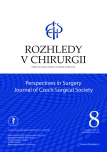Modern diagnostic approach to patients with abdominal aortic aneurysm
Authors:
L. Kubíček; R. Staffa; R. Vlachovský; T. Novotný; E. Biroš
Authors‘ workplace:
II. chirurgická klinika, Centrum cévních onemocnění, Fakultní nemocnice u sv. Anny v Brně a Lékařská fakulta Masarykovy univerzity, Brno
Published in:
Rozhl. Chir., 2022, roč. 101, č. 8, s. 401-409.
Category:
Original articles
doi:
https://doi.org/10.33699/PIS.2022.101.8.401–409
Overview
Introduction: Abdominal aortic aneurysm (AAA) is a relatively frequent and serious condition in vascular surgery. The diagnostic and indication process and its treatment are driven by the guidelines which dictate an intervention when the maximum AAA diameter is more than 55 mm. Nevertheless, this approach is not fully sufficient in all AAA cases and thus we have been seeking to develop a modern diagnostic tool using computer modeling and vascular wall stress analysis.
Methods: The project has been ongoing in cooperation with engineers from VUT Brno (Brno University of Technology) and VŠB Ostrava (Technical University of Ostrava) for ten years. The design of the analytical tool was created during the first, experimental period of the project; this tool is able to assess vascular wall stress from regular CT scans using the finite element method. This primary model was gradually altered and its precision was increased considerably in the course of the years using data from mechanical and histological tests of AAA wall specimens harvested during open repairs. Additionally, other patient specific data are included in the analysis such as blood pressure, gender and material characteristics.
Results: The effectiveness of the method was evaluated in a pseudo-prospective study, showing clear superiority of the vascular wall stress analysis over the maximum diameter approach. The method was used in clinical practice for the first time during restrictions due to the COVID-19 pandemic; based on the analysis we were able to assess which AAA cases can be postponed and which had a high risk of rupture and an intervention was required despite the restrictions. The method achieved 100% sensitivity, and its specificity was also much better compared to the maximum diameter approach.
Conclusion: The vascular wall stress analysis of AAA seems to be much more precise than the classic indication approach based only on the maximum diameter, and it can be used to determine the therapy based on patient specific parameters.
Keywords:
COVID-19 pandemic – finite element method – abdominal aortic aneurysm – indication process – vascular wall stress
Sources
1. Kent KC. Clinical practice. Abdominal aortic aneurysms. N Engl J Med. 2014;371(22):2101−2108. doi:10.1056/ NEJMcp1401430.
2. Singh K, Bønaa KH, Jacobsen BK, et al. Prevalence of and risk factors for abdominal aortic aneurysms in a population- based study: The Tromsø Study. Am J Epidemiol. 2001;154(3):236−244.
3. MacSweeney ST, Powell JT, Greenhalgh RM. Pathogenesis of abdominal aortic aneurysm. Br J Surg. 1994;81(7):935−941.
4. Brown LC, Powell JT. Risk factors for aneurysm rupture in patients kept under ultrasound surveillance. Ann Surg. 1999;230(3):289.
5. Ashton HA, Buxton MJ, Day NE, et al. The multicentre aneurysm screening study (MASS) into the effect of abdominal aortic aneurysm screening on mortality in men: A randomised controlled trial. Lancet Lond Engl. 2002;360(9345):1531−1539.
6. Brewster DC, Cronenwett JL, Hallett JW, et al. Guidelines for the treatment of abdominal aortic aneurysms. Report of a subcommittee of the Joint Council of the American Association for Vascular Surgery and Society for Vascular Surgery. J Vasc Surg. 2003;37(5):1106−1117. doi:10.1067/mva.2003.363.
7. Patel R, Sweeting MJ, Powell JT, et al. EVAR trial investigators. Endovascular versus open repair of abdominal aortic aneurysm in 15-years’ follow-up of the UK endovascular aneurysm repair trial 1 (EVAR trial 1): a randomised controlled trial. Lancet Lond Engl. 2016;388(10058):2366−2374. doi:10.1016/S0140-6736(16)31135-7.
8. Nicholls SC, Gardner JB, Meissner MH, Johansen KH. Rupture in small abdominal aortic aneurysms. J Vasc Surg. 1998;28(5):884−888. doi:10.1016/S0741- 5214(98)70065-5.
9. Reddy J. Introduction to the finite element method. Vol. 2006. USA, Columbus, McGraw-Hill.
10. Rodriguez JF, Ruiz C, Doblare M, et al. Mechanical stresses in abdominal aortic aneurysms: Influence of diameter, asymmetry, and material anisotropy. J Biomech Eng-Trans Asme. 2008;130(2):021023. doi:10.1115/1.2898830.
11. Polzer S, Gasser TC, Markert B, et al. Impact of poroelasticity of intraluminal thrombus on wall stress of abdominal aortic aneurysms. Biomed Eng Online 2012;11:62. doi:10.1186/1475-925X-11-62.
12. Auer M, Gasser TC. Reconstruction and finite element mesh generation of abdominal aortic aneurysms from computerized tomography angiography data with minimal user interactions. IEEE Trans Med Imaging 2010;29(4):1022−1028. doi:10.1109/TMI.2009.2039579.
13. Polzer S, Gasser TC, Bursa J, et al. Importance of material model in wall stress prediction in abdominal aortic aneurysms. Med Eng Phys. 2013;35(9):1282−1289. doi:10.1016/j. medengphy.2013.01.008.
14. Khang EK, Nathan DP, Woo EY, et al. Local wall thickness in finite element models improves prediction of abdominal aortic aneurysm growth. J Vasc Surg. 2015;61(1):217−223. doi:10.1016/j.jvs. 2013.08.032.
15. Gasser TC, Nchimi A, Swedenborg J, et al. A novel strategy to translate the biomechanical rupture risk of abdominal aortic aneurysms to their equivalent diameter risk: Method and retrospective validation. Eur J Vasc Endovasc Surg. 2014;47(3):288−295. doi:10.1016/j. ejvs.2013.12.018.
16. Polzer S, Gasser TC. Biomechanical rupture risk assessment of abdominal aortic aneurysms based on a novel probabilistic rupture risk index. J R Soc Interface. 2015;12(113):20150852. doi:10.1098/rsif. 2015.0852.
17. Polzer S, Gasser TC, Vlachovsky R, et al. Biomechanical indices are more sensitive than diameter in predicting rupture of asymptomatic abdominal aortic aneurysms. J Vasc Surg. 2020;71(2):617−626. doi:10.1016/j.jvs.2019.03.051.
Labels
Surgery Orthopaedics Trauma surgeryArticle was published in
Perspectives in Surgery

2022 Issue 8
Most read in this issue
- Complications and pitfalls of endovenous laser therapy for varicose veins of lower extremities
- Endovenous laser ablation of saphenous veins – favorable clinical results confirm theoretical advantages of the 1940nm diode laser
- Unique robotic vascular surgery procedures
- Efficacy and safety of urgent carotid endarterectomy in patients with acute ischemic stroke
